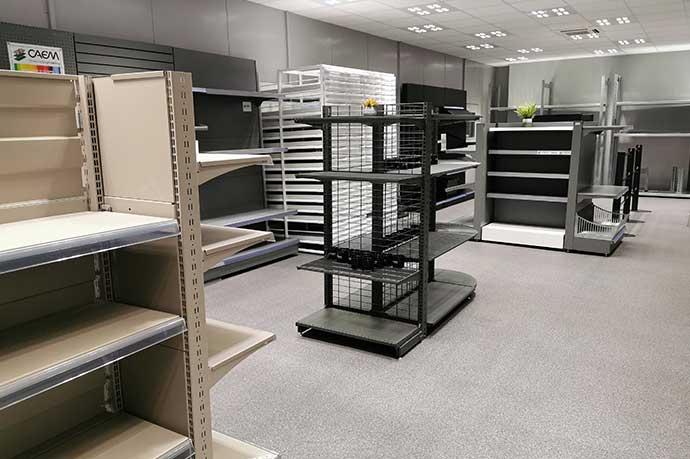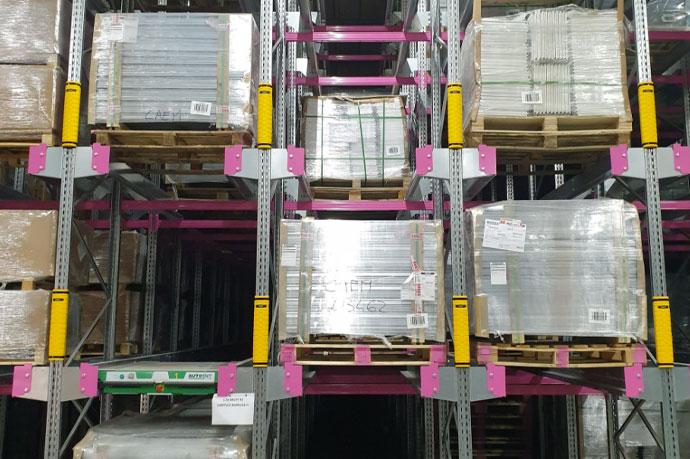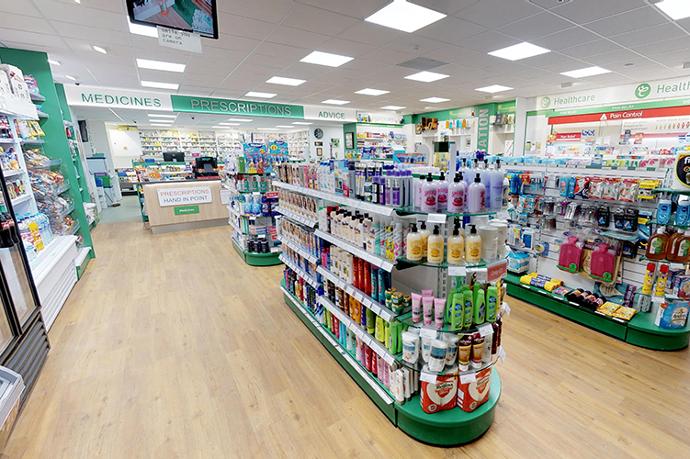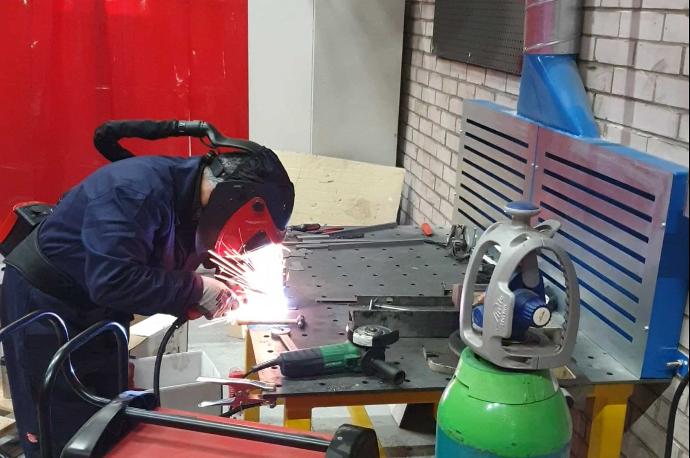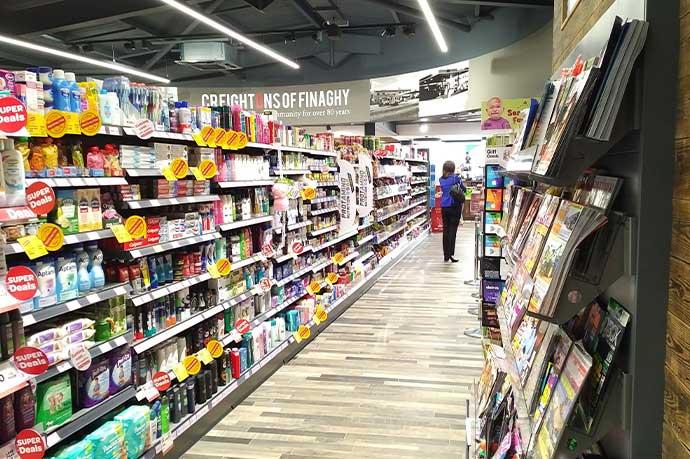In the bustling world of convenience stores, where quick access and easy navigation are paramount, the role of shelving cannot be understated. Shelves for convenience stores are not just functional necessities; they are strategic assets that shape the shopping experience. Thoughtfully designed shelving transforms a casual shopper into a loyal customer by presenting products in an organized, visually appealing manner. With a growing recognition of shelving's importance, businesses are now investing in innovative solutions to enhance customer engagement and streamline operations. This guide explores the intricacies of selecting and optimizing shelving solutions to elevate both store performance and customer satisfaction.
Understanding the Importance of Convenience Store Shelving
Convenience store shelving serves as the backbone of the retail environment, influencing everything from product visibility to customer flow. The strategic placement and design of shelves can significantly impact a store's ability to convert foot traffic into sales. According to NACS, the average weighted in-store inventory in a convenience store is $81,493 in U.S. dollars, emphasizing the need for efficient shelving to manage and showcase this substantial investment.
Smart shelving systems are more than just storage solutions; they are a strategic investment in the store's success. By enhancing customer flow and maximizing product visibility, these systems play a critical role in shaping the shopping experience. The shelving market's expansion reflects the growing recognition of these systems as vital components of retail success.
From my experience in the industry, I have seen how CAEM, a UK-based company, excels in designing and manufacturing customized retail display solutions. Since 1958, CAEM has been pioneering innovations that cater to the unique needs of retailers, ensuring that every shelf contributes to a seamless shopping journey. Their emphasis on customization and innovation highlights the transformative power of well-designed shelving in boosting store performance.
The average convenience store inventory turns approximately 11.5 times per year, according to NACS data. This frequency underscores the importance of having adaptable and efficient shelving solutions that can keep up with the dynamic nature of retail. By investing in high-quality shelving, store owners can optimize their space, enhance product accessibility, and ultimately, foster a more engaging shopping environment.
Types of Shelving Solutions for Convenience Stores
Selecting the right store shelving solutions is pivotal for convenience stores aiming to maximize space and enhance the shopping experience. Different shelving types offer unique benefits, from optimizing aisle space to accommodating diverse product lines. Here’s a closer look at some of the most effective retail shelving solutions.
Wall Units: Maximising Aisle Space
Wall units are an excellent choice for maximizing vertical space, making them particularly beneficial for smaller stores. By placing products at eye level, these units enhance visibility and accessibility, ensuring that customers can easily find what they need. Wall units effectively utilize otherwise wasted space, allowing stores to display more products without crowding the aisles. This strategic use of space helps maintain a clean and organized store layout, encouraging a smoother shopping flow.
Gondola Shelving: Versatility and Functionality
Gondola shelving stands out for its versatility and functionality, making it a staple in retail environments. These units can be easily rearranged and adapted to showcase different product types and promotional displays. CAEM, a leader in retail shelving solutions, manufactures gondola shelving systems that are both durable and adaptable, allowing retailers to tailor their layouts according to specific needs. With the ability to transform store configurations quickly, gondola shelving offers unparalleled flexibility for dynamic retail spaces.
Modular Systems: Adaptability to Store Layouts
Modular systems provide a customizable solution for stores that require adaptable layouts. These systems allow retailers to adjust configurations to fit evolving product ranges and seasonal demands. CAEM’s TN9 and S50 systems exemplify this adaptability with their modular design and versatile features. Retailers can seamlessly integrate these systems into their existing layouts, ensuring that their shelving meets both current and future needs. The flexibility of modular systems makes them an ideal choice for stores that value adaptability and efficiency.
Specialized Shelving Solutions: Meeting Unique Needs
For stores with specific display challenges, specialized shelving solutions offer tailored designs that address unique requirements. Whether it’s a pharmacy needing modular drawer systems like CAEM’s D25 or a hardware store requiring custom configurations, specialized shelving caters to these distinct needs. CAEM’s ability to provide bespoke manufacturing options ensures that retailers receive shelving solutions that are perfectly aligned with their operational goals. By meeting the unique demands of different store types, specialized shelving enhances both functionality and customer experience.
In summary, the diverse range of shelving solutions available today enables convenience stores to optimize their space and improve product accessibility. By choosing the right type of retail shelving, stores can create an inviting shopping environment that meets both customer expectations and business objectives.
Strategic Design for Maximising Store Space
Effective store shelving design is crucial for making the most of available space in a convenience store. By optimizing layout and flow, utilizing vertical space, and incorporating customizable features, retailers can significantly enhance the shopping experience and boost sales.
Optimising Layout and Flow
The strategic placement of shelving is instrumental in guiding customer flow throughout the store. By positioning high-demand items in easily accessible areas, stores can naturally draw customers deeper into the space, encouraging them to explore and discover additional products. This approach not only increases the visibility of lesser-known items but also promotes impulse purchases, which are a vital component of retail success. By designing logical pathways with clear sightlines, retailers can create an intuitive shopping journey that enhances customer satisfaction and engagement.
Making Use of Vertical Space
Vertical space is often an underutilized asset in retail environments. By leveraging tall store shelving units, retailers can prevent floor overcrowding while displaying a wider range of products. This approach is particularly beneficial in smaller stores, where maximizing every inch of space is essential. Utilizing vertical space allows for a more organized presentation, ensuring that products are accessible and visible without overwhelming the shopper. By freeing up floor space, stores can maintain a clean and inviting atmosphere, further enhancing the customer experience.
Customizable Features to Suit Various Product Lines
Incorporating customizable features into store shelving allows retailers to tailor displays to fit diverse product lines. Whether dealing with bulky items or delicate merchandise, adjustable shelving can accommodate varying dimensions and presentation styles. This flexibility is crucial for retailers who frequently update their product offerings or run seasonal promotions. By investing in customizable shelving solutions, stores can ensure that their displays remain relevant and appealing, adapting seamlessly to changing market trends and consumer preferences.
In conclusion, strategic design choices in store shelving can transform a retail space, enhancing both functionality and customer appeal. By optimizing layout and flow, making smart use of vertical space, and employing customizable features, retailers can create a dynamic and engaging shopping environment that supports business growth and customer loyalty.
Choosing the Right Shelving to Enhance Your Offerings
Selecting the right shelves for convenience stores is a critical step in enhancing product presentation and optimizing the shopping experience. By considering factors such as durability, visual appeal, and tailored solutions, retailers can effectively showcase their offerings while maintaining a functional and attractive store environment.
Considering Durability and Load Capacity
When choosing shelves for convenience stores, it's essential to prioritize durability and load capacity. Shelving must withstand the rigors of daily use and support a wide range of product weights. This ensures longevity and safety, particularly in high-traffic areas. CAEM's advanced manufacturing techniques produce robust shelving systems like the TN9 and S50, designed to meet these demands. Their focus on quality and resilience ensures that retailers can rely on their shelving to perform consistently over time, safeguarding both products and customer satisfaction.
Veer Balance Between Functionality and Visual Appeal
Effective store shelving strikes a harmonious balance between functionality and visual appeal. While the primary goal is to support and organize products efficiently, the aesthetic design should also enhance the overall store ambiance. An attractive shelving display can captivate customers, encouraging them to explore more of the store. CAEM excels in creating visually appealing shelving solutions without compromising on practicality, ensuring that retailers can present their products in the best possible light while maintaining ease of access and organization.
Tailored Solutions for Different Product Categories
Different product categories require tailored shelving solutions to meet their specific display needs. For instance, a pharmacy may need modular drawer systems like CAEM's D25, while a convenience store might benefit from versatile gondola shelving. CAEM's expertise in serving various retail sectors, from clothing stores to homewares, allows them to offer bespoke solutions that cater to each retailer's unique requirements. By selecting shelving systems that align with their product categories, retailers can optimize space utilization and enhance the customer shopping experience.
In summary, choosing the right shelving involves a careful consideration of durability, aesthetics, and customization. By investing in high-quality, tailored shelving solutions, retailers can not only improve the functionality of their stores but also create an inviting and efficient shopping environment that enhances their product offerings.
Advantages of Modern Convenience Store Shelving
Modern convenience store shelving is a game-changer in retail, offering enhanced product visibility, ergonomic designs, and adaptability to market changes. These advantages not only improve store operations but also elevate the shopping experience, ensuring long-term competitiveness in a rapidly evolving market.
Enhanced Product Visibility and Organisation
Contemporary shelving systems significantly boost product visibility and organization, making it easier for customers to locate and select items. This improvement in accessibility directly contributes to increased sales and customer satisfaction. The global Ambient Retail Shelving market is projected to reach USD 6518.2 million by 2024, highlighting the growing importance of effective store shelving solutions. CAEM’s expertise in manufacturing bespoke retail shelving ensures that each system is tailored to enhance product presentation and maximize store efficiency.
Incorporating Ergonomics into Displays
Incorporating ergonomics into store shelving designs improves accessibility for both customers and staff. Ergonomic shelving facilitates easier product access, reducing the physical strain on shoppers and enhancing the overall shopping experience. This design consideration also streamlines restocking processes, allowing staff to work more efficiently. CAEM's advanced manufacturing capabilities, including in-house design and fabrication, enable the creation of ergonomic shelving systems that meet the specific needs of modern retailers.
Flexibility and Aesthetic Value
The flexibility and aesthetic value of modern shelving play a crucial role in defining a store's brand identity. With a variety of design and color options available, retailers can create visually appealing environments that resonate with their target audience. The global Retail Shelving Market size is expected to grow at a CAGR of 8.89%, reflecting the increasing demand for flexible and attractive shelving solutions. CAEM offers a range of customizable shelving systems, such as the TN9 and S50, which provide retailers with the versatility needed to adapt to changing trends and consumer preferences.
Adapting to Market Dynamics and Growth
As market dynamics evolve, shelving systems that can adapt to these changes ensure long-term success. The global smart shelves market is projected to grow at a CAGR of 24.2% from 2024 to 2030, underscoring the importance of innovation in retail shelving. CAEM’s commitment to providing adaptive solutions, through features like modular designs and bespoke manufacturing, empowers retailers to respond swiftly to market shifts and capitalize on growth opportunities.
In conclusion, modern convenience store shelving offers numerous advantages that enhance both operational efficiency and customer experience. By focusing on visibility, ergonomics, flexibility, and adaptability, retailers can position themselves for sustained success in a competitive market landscape.
Enhancing Customer Engagement Through Smart Shelving
In the competitive landscape of convenience stores, engaging customers effectively is paramount. Smart shelving solutions, particularly those that leverage eye-level displays, interactivity, and trend alignment, can significantly enhance customer engagement and drive sales.
Leveraging Eye-Level Displays for Impact
Eye-level displays are a powerful tool in capturing customer attention and boosting sales. By strategically placing high-margin and promotional products at eye level, retailers can ensure these items are noticed and considered by shoppers. This approach is especially effective for shelves for convenience stores, where quick decision-making is common. Ensuring that popular products are prominently displayed can mitigate the risk of out-of-stocks, which could cause a store to lose one in every 100 customers completely. By optimizing product placement, stores can maintain customer satisfaction and loyalty.
Interactivity and Theme-Based Presentation
Incorporating interactivity and theme-based presentations into store shelving can create a more immersive shopping experience. Technology-enhanced displays, such as digital screens and interactive elements, allow customers to engage with products on a deeper level. This engagement can lead to longer visits and increased purchases, as customers are drawn into the thematic elements and interactive features of the display. By crafting memorable shopping experiences, stores can differentiate themselves from competitors and foster a stronger connection with their customers.
Aligning with Emerging Market Trends
Staying attuned to emerging market trends is essential for maintaining relevance in the retail sector. By aligning shelving strategies with current consumer preferences, stores can ensure they remain responsive to market demands. For example, a major convenience store retailer saw a 59% increase in retail sales for the fresh category after implementing Shelf Engine's automated ordering system. This success underscores the importance of adapting shelving and inventory strategies to meet evolving consumer expectations. By doing so, retailers can enhance their offerings and sustain growth in a dynamic market environment.
In conclusion, smart shelving solutions that focus on visibility, interactivity, and trend alignment can significantly enhance customer engagement. By leveraging these strategies, convenience stores can create a compelling shopping experience that not only attracts but also retains customers, ensuring long-term success.
Best Practices for Shelving Maintenance and Organisation
Maintaining well-organized and efficient store shelving is crucial for optimizing the shopping experience and enhancing operational effectiveness. Implementing best practices in maintenance, product positioning, and restocking can ensure that retail shelving remains functional and visually appealing.
Scheduled Maintenance Procedures
Regular maintenance is essential to keep store shelving in top condition. This involves routine checks for wear and tear, cleaning to maintain a pristine appearance, and ensuring all components are secure. Scheduled maintenance not only prolongs the life of retail shelving but also contributes to a clean and inviting store environment, which can positively influence customer perceptions. By adopting a proactive approach to maintenance, retailers can prevent minor issues from escalating into costly repairs, ensuring that their shelves always present products in the best possible light.
Effective Product Positioning Strategies
Effective product positioning is a powerful tool for enhancing product visibility and accessibility. By strategically placing items where they are most likely to catch the customer's eye, retailers can encourage impulse purchases and improve the overall shopping experience. High-demand and promotional items should be placed at eye level to maximize their impact. Additionally, grouping related products together can simplify decision-making for customers, making their shopping journey more intuitive. Thoughtful positioning not only increases sales potential but also enhances customer satisfaction by making products easy to find and access.
Streamlined Restocking Techniques
Efficient restocking techniques are vital for maintaining a full and orderly appearance on store shelves. Utilizing AI-powered inventory management systems can optimize shelf stocking, reduce food waste, and improve overall store efficiency. These systems predict demand patterns, ensuring that popular items are always available and minimizing the risk of out-of-stocks. By streamlining restocking processes, retailers can maintain a seamless shopping experience, where customers consistently find their preferred products in stock, enhancing both loyalty and sales.
In summary, implementing best practices in shelving maintenance and organization is key to maximizing the effectiveness of retail shelving. By focusing on regular maintenance, strategic product positioning, and efficient restocking, stores can ensure a well-organized, appealing, and customer-friendly environment.
Upcoming Trends in Convenience Store Shelving
The landscape of convenience store shelving is evolving rapidly, driven by technological innovations, personalization, and sustainability. These emerging trends are reshaping how retailers approach store shelving, enhancing both operational efficiency and customer satisfaction.
Incorporation of Technological Innovations
Technological advancements are revolutionizing shelves for convenience stores, offering features like inventory tracking and digital displays. These innovations streamline operations by providing real-time data on stock levels and customer preferences, enabling retailers to make informed decisions quickly. Digital displays can engage customers with dynamic content, promoting products and offers in a visually appealing manner. By integrating these technologies into retail shelving, stores can enhance customer engagement and improve the overall shopping experience.
Personalisation and Adaptive Solutions
The demand for personalized and adaptive shelving solutions is growing as retailers seek to tailor their displays to meet specific store needs and customer preferences. Adaptive shelving systems can be easily reconfigured to accommodate different product lines, seasonal promotions, or changing consumer trends. This flexibility allows stores to remain agile and responsive, ensuring that their retail shelving always aligns with current market demands. Personalization not only improves operational efficiency but also strengthens customer loyalty by providing a shopping experience that feels tailored and relevant.
Sustainability and Eco-Friendly Options
Sustainability is becoming a crucial consideration in the design of store shelving. Consumers increasingly expect retailers to adopt eco-friendly practices, and shelving made from sustainable materials is a key component of this shift. Incorporating energy-efficient LED lighting into shelving enhances product visibility while supporting sustainability initiatives. This focus on eco-friendly options not only reduces environmental impact but also aligns with consumer values, enhancing brand reputation and customer trust.
In summary, the future of convenience store shelving lies in embracing technological innovations, personalization, and sustainability. By integrating these trends into their shelving strategies, retailers can create a more efficient, engaging, and environmentally responsible shopping environment that meets the evolving expectations of today's consumers.
Conclusion: Selecting the Right Shelving to Elevate Customer Experience
Selecting the right shelves for convenience stores is a strategic decision that significantly impacts both customer experience and store performance. The choice of shelving not only influences the aesthetic appeal of a store but also determines how efficiently space is utilized and how effectively products are presented. By investing in thoughtfully designed shelving solutions, retailers can create a welcoming and efficient shopping environment that enhances customer satisfaction and drives store success.
The right shelving system should align with the store's unique needs, offering flexibility, durability, and visual appeal. As consumer expectations evolve, incorporating features like technological innovations and sustainable materials can further elevate the shopping experience. By prioritizing these elements, retailers can ensure their store shelving remains relevant and responsive to market trends.
Ultimately, the investment in high-quality shelves for convenience stores pays dividends in the form of increased customer loyalty and improved sales performance. By focusing on creating an engaging and efficient retail environment, stores can not only meet but exceed customer expectations, securing their place in a competitive market.
